“I’d like to be remembered as an innovator,” he said, speaking from the interior of one of OceanGate’s submersibles. “I think it was [famous American General Douglas] MacArthur that said, ‘You’re remembered for the rules you break.’”
“I have broken some rules to make this,” he conceded. “I think I’ve broken them with logic and good engineering behind me. The carbon fiber and titanium—there is a rule that you don’t do that. Well, I did.”



Honestly, it’s almost certainly possible to make a deep sea tour sub like this that’s reasonably safe, if even more expensive (though given the only clientele for this kind of tourism is so incredibly rich I’m not sure this really matters). Consider that subs capable of operating at this depth have existed for a long time, for example, the Alvin , which was built in the 60s, can go to the wreck of the Titanic and even deeper, and yet still gets used today.
Yeah, James Cameron has been to the Titanic and back 33 times. And to the Mariana Trench, and who knows where else. It’s not impossible to do it safely, but that requires spending money on the correct materials, listening to your engineers, cross checking with third party engineers, and not rushing things. Carbon fiber is a stupid material for a sub hull, using different materials with different expansion and contraction rates for your pressure vessel is a stupid decision, not having a way for the passengers to self-rescue is stupid, using a wireless controller without (multiple) hardwired backups is stupid.
The entire thing reeks of a CEO who doesn’t want to take the time to do things properly in fear of investors losing interest. And I get that fear, I work for a small company as well (not building submarines) and you do have to move quickly with a lot of things. But you DON’T rush things when human safety is a factor.
That sub should have been remotely operated dozens of times and gone through multiple iterations before they ever let a living creature inside it. It should have been x-rayed between every dive to find microfractures in the brittle carbon fiber hull. Multiple prototypes should have been built and extensively tested to find flaws in the design or assembly process.
Wow apparently that Alvin was built by General Mills! (Electronic division.) Like the cereal company. Also it say:
That’s a good idea. I wonder if they just are not allowed to go on the alvin no matter how much they pay, and thats why they chose other option?
I wasn’t suggesting that they actually use that sub for their tour, the Alvin does have actual work it does (has made some pretty important contributions to science to my knowledge, for instance in visiting thermal vents) so I doubt they’d be allowed to just rent it out for sightseeing. Rather, I was more trying to point out using it as an example that building a reasonably safe and reliable sub for this kind of depth is not only possible, it has been for quite some time now. It reflects extremely poorly on the design and operators of the Titan that it could not.